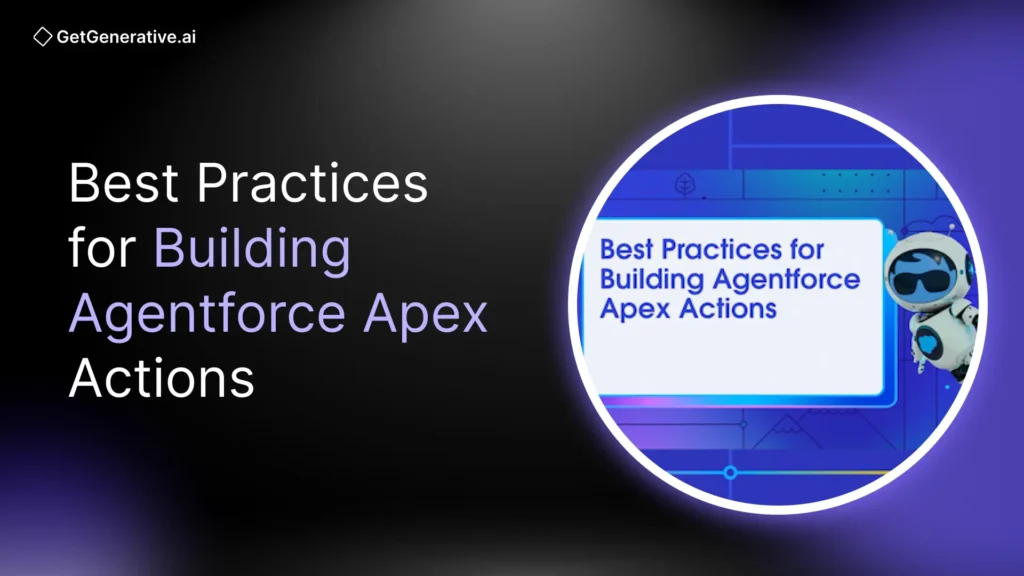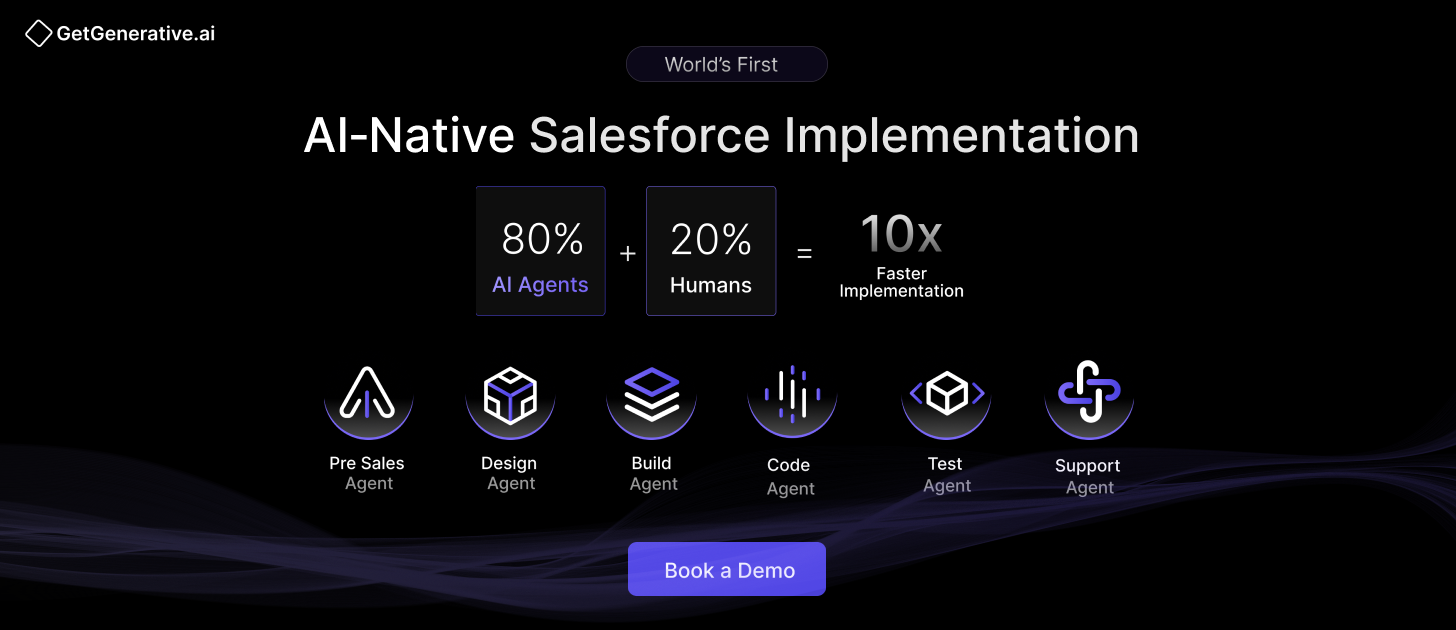Best Practices for Building Agentforce Apex Actions
The rise of Salesforce Agentforce marks a defining shift in enterprise AI. Moving beyond the limitations of chatbots, Agentforce enables autonomous agents capable of executing complex workflows with human-like reasoning. Already adopted by over 8,000 enterprises, this agentic AI platform is redefining automation strategy.
Yet, the true measure of success does not lie in deployment alone—it lies in how well Apex actions are designed for the Atlas Reasoning Engine, ensuring they are secure, performant, reusable, and enterprise-ready.
Salesforce’s own implementation underscores this potential: its Agentforce-powered Help system resolved 81% of inquiries within the first month, outperforming prior chatbot solutions by 2x and projecting $50 million in annual savings. These results are only possible when best practices are applied consistently in building Apex actions.
Architecting for the Atlas Reasoning Engine
Understanding the Reasoning Framework
Atlas Reasoning Engine is a cognitive orchestration layer that executes a four-step process of planning, evaluation, refinement, and retrieval. Unlike deterministic automation, Atlas interprets natural language, analyzes business context, and dynamically selects the most appropriate action sequence.
This probabilistic reasoning model requires a mindset shift from developers: Apex actions must be designed with metadata clarity so Atlas can recognize their purpose, inputs, and dependencies. Labels, descriptions, and parameter definitions in invocable methods are not just documentation—they are the very signals Atlas uses to decide when, how, and why to execute an action.
Designing Invocable Methods for AI Comprehension
Apex actions form the execution layer for Atlas. To maximize agent intelligence, invocable methods must provide rich metadata that helps the engine understand their context.
Example:
@InvocableMethod(
label = ‘Update Customer Order Status’,
description = ‘Updates the status of a customer order and sends notification. Use when customers request order status changes or when fulfillment status updates occur.’
)
public static List<OrderUpdateResult> updateOrderStatus(List<OrderUpdateRequest> requests) {
// Implementation
}
- Label → concise, descriptive, and user-oriented.
- Description → explains the purpose, context, and recommended scenarios for execution.
- Metadata synchronization → alignment between Apex code and Agent Builder configuration ensures consistency and reduces reasoning errors.
Implementing Generic Actions for Reusability
Enterprise environments evolve constantly, and Apex actions must be built for flexibility and reusability. Generic actions—those capable of working across multiple object types—minimize tight coupling to specific schemas and enable agents to handle diverse business processes.
For example, a generic approval action can submit records for approval regardless of their object type:
public class GenericApprovalAction {
@InvocableMethod(
label = ‘Submit Record for Approval’,
description = ‘Initiates approval process for any record type that supports approval workflows’
)
public static List<ApprovalResult> submitForApproval(List<ApprovalRequest> requests) {
// Implementation
}
}
This design pattern ensures long-term maintainability, allowing agents to adapt as objects and workflows evolve—without requiring constant code rewrites.
Security Architecture and Trust Boundaries
Understanding Agentforce Security Contexts
Security in Agentforce follows layered trust boundaries. The context depends on the agent type:
- Employee Agents → inherit the permissions of the logged-in Salesforce user.
- Service Agents → execute with permissions of the user assigned during creation.
This distinction influences how security checks are implemented in Apex actions. For authenticated Experience Cloud scenarios, agents inherit user permissions. But for public-facing Service Agents, stricter measures are required to prevent unauthorized access or data leakage.
Implementing Secure Action Patterns
Security in Agentforce cannot rely solely on platform-level controls. Because autonomous agents make independent decisions, security must be enforced in code.
public with sharing class SecureCaseAction {
@InvocableMethod(
label = ‘Retrieve Customer Case Details’,
description = ‘Securely retrieves case information with user permission validation’
)
public static List<CaseDetails> getCaseDetails(List<CaseRequest> requests) {
if (!Schema.sObjectType.Case.isAccessible()) {
throw new AuraHandledException(‘Insufficient permissions to access Case data’);
}
// Implementation
}
}
Key best practices:
- Use with sharing to enforce record-level security.
- Apply WITH USER_MODE in SOQL queries to respect field-level permissions.
- For public agents, add field filtering and data validation to protect sensitive information.
User Verification for Sensitive Actions
For private or sensitive actions (e.g., financial transactions), user verification must be embedded.
private static Boolean verifyUserIdentity(String userId, String verificationCode) {
return CustomerVerificationService.validate(userId, verificationCode);
}
Verification may involve multi-factor checks such as SMS codes, email confirmation, or knowledge-based validation, depending on organizational security policies.
Also Read – Best AI Tools for Salesforce Proposal Generation
Performance Optimization Strategies
Agentforce Governor Limits
Apex actions in Agentforce run under the Salesforce governor limit framework but with important differences:
- Each action runs in its own transaction with full synchronous limits (10s CPU, 100 SOQL queries, 150 DML statements).
- Limits are not shared across multiple agent calls.
This means while bulkification is not automatic, actions should still be bulk-ready to ensure scalability in both agent and Flow contexts.
Bulkification Patterns for Agent Actions
@InvocableMethod(
label = ‘Process Multiple Orders’,
description = ‘Efficiently processes multiple order updates in a single transaction’
)
public static List<OrderProcessResult> processOrders(List<OrderProcessRequest> requests) {
// Bulkified implementation
}
Key benefits:
- Efficient handling of single and bulk requests.
- Optimized governor limit usage.
- Greater reusability across contexts (Flows, agents, integrations).
Optimizing SOQL and DML
Bad practice:
List<Account> accounts = [SELECT * FROM Account WHERE Industry = :industry];
Best practice:
List<Account> accounts = [
SELECT Id, Name, Industry, AnnualRevenue
FROM Account
WHERE Industry = :industry
AND AnnualRevenue > :minimumRevenue
AND IsActive__c = true
LIMIT 200
WITH USER_MODE
];
Selective fields, filters, and limits reduce CPU time and heap size, especially in large data volume (LDV) scenarios. Where applicable, integrate with Salesforce Data Cloud for analytics-scale queries.
Asynchronous Processing for Large Datasets
For long-running processes, synchronous execution may exceed governor limits. Implement Queueable Apex to handle background jobs while returning immediate feedback to users.
System.enqueueJob(new LargeDataProcessor(request, trackingId));
Agents can then provide status updates via Platform Events, emails, or tracking queries, ensuring user experience remains seamless.
Robust Error Handling and User Experience
Implementing Comprehensive Error Handling
Unlike developer-facing Apex code, Agentforce Apex actions operate in conversational contexts. That means user-facing error messages must be clear and actionable, not technical. Errors should be gracefully handled to allow partial success while communicating useful feedback.
Example:
@InvocableMethod(
label = ‘Create Customer Support Case’,
description = ‘Creates a new support case with robust error handling’
)
public static List<CaseCreationResult> createSupportCase(List<CaseCreationRequest> requests) {
// Input validation + partial success handling
}
Best practices:
- Validate inputs upfront to avoid unnecessary execution.
- Use Database.SaveResult with allOrNone = false to allow partial success.
- Aggregate and relay meaningful error messages to the Atlas Reasoning Engine.
Designing User-Friendly Responses
Response structures should prioritize clarity for end users while maintaining metadata richness for Atlas.
public class CaseCreationResult {
@InvocableVariable(label = ‘Success’)
public Boolean isSuccess;
@InvocableVariable(label = ‘Case ID’)
public String caseId;
@InvocableVariable(label = ‘Message’)
public String message;
}
- Success flags → help Atlas decide follow-up actions.
- Friendly messages → enhance the conversational flow.
- Metadata-rich descriptions → support maintainability.
Testing Strategies and Quality Assurance
Multi-Layer Testing Approach
Agentforce testing requires more than just unit tests. It spans three levels:
- Unit Testing → validates Apex logic, governor limit compliance, and input handling.
- Integration Testing → validates how Atlas classifies topics and selects Apex actions.
- End-to-End Agent Testing → validates conversational accuracy using the Agentforce Testing Center.
Example unit test snippet:
@isTest
static void testBulkOrderProcessing() {
// Setup, execute, and validate governor limits
}
Agentforce-Specific Testing Tools
Salesforce provides dedicated tools for agent testing:
- Agentforce Testing Center → bulk test agent responses across utterances.
- Agent Builder Live Testing → real-time debugging during development.
- LLM-as-a-Judge → subjective validation of response quality.
Continuous Monitoring in Production
To ensure ongoing reliability, establish KPIs for Agentforce actions:
- Topic Classification Accuracy → % of correct intent recognition.
- Action Success Rate → % of successful executions.
- Response Quality → user satisfaction scores.
- Performance Metrics → latency, SOQL/DML usage.
Continuous monitoring enables early detection of performance drift.
Also Read – Typical Salesforce Implementation Costs in 2025: Complete Pricing Guide
Enterprise Deployment Patterns
Scaling Agentforce Across Enterprises
Large organizations face challenges in scaling across multiple business units and geographies. Best practices include:
- Phased rollout → start with one use case, then expand.
- Multi-business unit support → configure agent permissions and security contexts carefully.
- Cross-org governance → enforce consistent testing, logging, and approval processes.
Examples: enterprises like PepsiCo, Grupo Globo, and Engine began with targeted customer service use cases before expanding platform-wide.
Integration Architecture Patterns
With Agentforce, integration is no longer optional—it’s core. Using Model Context Protocol (MCP), actions can connect seamlessly to 30+ partner systems (AWS, IBM, Box, Cisco, Google Cloud).
Best practices:
- Standardize external API calls.
- Implement secure callouts with error handling.
- Use metadata-driven connectors where possible.
Governance and Compliance
While the Einstein Trust Layer provides baseline safeguards, enterprises must add:
- Data access controls (role-based).
- Audit logs (for compliance reporting).
- Data masking/anonymization (non-prod environments).
- Change management processes (for agent updates).
Business Impact and ROI
Quantifying Agentforce Value
Enterprises report:
- 70%+ inquiry resolution via AI agents.
- 65%+ self-service adoption.
- 15%+ productivity gains across support and sales.
Salesforce itself saw $50M annual savings from its Help system powered by Agentforce.
ROI Framework
ROI must capture both direct and indirect benefits:
- Cost savings → reduced manual labor.
- Productivity gains → staff reallocated to higher-value work.
- Revenue uplift → improved CX → better retention + sales.
- Efficiency → reduced response times and escalations.
According to Futurum Group, Agentforce customers realize ROI 5x faster with 20% lower costs than DIY automation.
Also Read – Getting Started with Salesforce OmniStudio: A Complete Beginner’s Guide
Conclusion
The message is clear: organizations that adopt these best practices will not just implement automation—they will transform it into a strategic advantage. With Agentforce evolving rapidly, now is the time to lay the foundations for scalable, secure, and future-proof AI agents that deliver real business impact.
At GetGenerative.ai, we’ve reimagined Salesforce implementation—built from the ground up with AI at the core. This isn’t legacy delivery with AI added on. It’s a faster, smarter, AI-native approach powered by our proprietary platform.
👉 Explore our Salesforce AI consulting services




